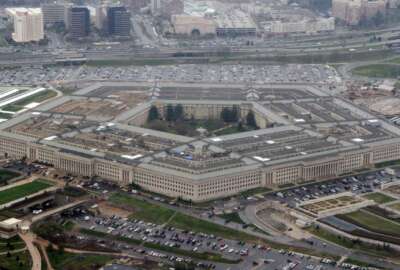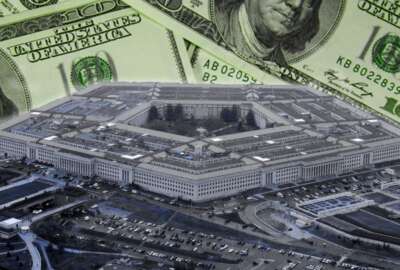Games can help a lot with military service member readiness
The annual Warrior Games bring together wounded, ill and injured service members and veterans in Olympic-style competition. They compete at what are called adaptive...
The annual Warrior Games bring together wounded, ill and injured service members and veterans in Olympic-style competition. They compete at what are called adaptive sports. Global Consulting Firm Booz Allen participated by bringing human performance and data analytics practitioners. For why, and what they learned, Federal Drive with Tom Temin spoke in studio with Munjeet Singh, the Senior Vice President of Booz Allen’s Bright Labs
Interview Transcript:
Munjeet Singh So the Warrior Games is something that was started by the Department of Defense about ten years ago. It essentially brings our active duty personnel together with our veterans, oftentimes, many of them who have experienced some sort of injury that was introduced while they were deployed. So you have a lot of physical disabilities. You also have a lot of mental, as we call them, invisible disabilities, where people are struggling emotionally or mentally due to some of the situations or experiences they had while they were overseas. And what the Warrior Games allows people to do as active duty personnel, as well as veterans, to come together and compete in adaptive sports in a way that really kind of harnesses their pride of the service that they’re representing kicks in that kind of inter-service competitive nature of it and then tees them up, most importantly for the Invictus Games, which is happening in September. That’s Prince Harry’s large program. And that is a multinational competition. So we have about 50 athletes from the Warrior Games, and then those 50 athletes are going to be going to Invictus Games to represent Team USA against other service members who are adaptive athletes on the global scale. What we did at the Warrior Games is we brought our human performance stack as well as some of our data analytics capabilities to really outfit those athletes. We outfitted about 70 athletes with ring wearables and then we linked it up to our data platform to help the athletes understand what their preparation needs to look like going into the games, what the strain that their training is taking on them on a daily basis, and how they need to fine tune that, really dial in sleep strategies and recovery strategies and show them the benefit of some restorative activities like yoga, like Pilates, or just even some basic dynamic stretching. They’re also working really closely with our coaches to help them understand the benefits of all these, not only for the games but for their their life. A lot of times in talking to these athletes, they are taking multiple medications, whether it’s painkillers or antidepressants, sleep supplements. And you can imagine just the impact and the toll this takes on some of our veterans bodies. And so having the opportunity to link up with our coaches who are all formally trained in kinesiology or sports science or cognitive therapy are helping them really understand what capabilities to kind of introduce into our life on a daily basis. So it it was awesome for us because it gives us an opportunity to engage with a community of users that we care very deeply about, obviously as American citizens. But then for our coaches to have an opportunity to impact their lives.
Tom Temin But the takeaway here is that the idea of application of data analytics, artificial intelligence, sensing, Internet of Things, all of these converging technologies can be used throughout the life cycle of a member of the armed services, from ingestion to training to helping them be more effective if they should be called into battle. And then when they’re veterans and maybe in recovery.
Munjeet Singh That’s exactly right. I mean, for active duty personnel, it’s you’re hitting on a perfectly right because it hits to a much larger opportunity, and that is readiness. We need to assess the readiness levels of our armed services across the country, especially, as we continue to have flash points on the geopolitical scale and stage with some of our peer and near-peer adversaries. It’s becoming more and more critical that we’re able to assess that readiness at scale. And then it’s becoming more and more critical, as it always has been, that we extend and do everything that we can to care for our veteran population. And so I think these devices, we take them for granted these days. I’m wearing I’m sitting here talking to you and I’m wearing no less than three devices that are measuring my my physiological responses because I’m a nerd in the space. Right. But all of us have a Fitbit or an Apple Watch.
Tom Temin Plus, our microphones are extremely powerful. They catch much more than voice.
Munjeet Singh You’re probably picking up weird voice patterns and detecting, you know that I’m nervous right now as an example. But yeah, it’s we take them for granted. But the power that it has to really allow us to embrace this community of users that needs our attention, it’s right there for us. And so we just have to figure out the right way to navigate security policies and make sure that it’s scalable across the country.
Tom Temin And I wanted to ask you about spatial computing in this context, because we recently ran an interview in which we found out that the Veterans Health Administration is using high end virtual spacial, those funny things you put on their head for lots of therapeutic purposes. So spatial computing that it’s not just fun and games and this idea of virtual reality, spatial computing, how is that coming into the federal area, do you think?
Munjeet Singh It’s been interesting. I think we are starting to see we’re starting to reach an inflection point. And I think certainly the announcement by Apple is going to help.That announcement I think, took a lot of people by surprise. It’s a headset that costs $3,500. Well, it’s not necessarily targeted towards consumers. It really is targeted with these enterprise use cases in mind. And a lot of the work that the government is doing informed their design. And so I think we are at a point now where we’re starting to see those barriers break down. But yeah, we’re seeing it across what we call partial task trainers. If there’s a loadmaster of a C-130 who needs to run through the paces of the right way to secure the load to prevent a catastrophic accident on that flight, they get opportunities to do that without commandeering an entire C-130. We see the same thing with close quarter combat operations like room clearing, where we give people the opportunity to kind of run through repetitions and really get time without having to commandeer an entire facility. More cognitive exercises as well with our special operators, helping them understand different cognitive tools that they can employ while they’re deployed out in the field that will help them bring their metrics in line. And then we’re starting to get into the facility space as well. So you mentioned what the VA is doing for rehab purposes. That’s great because it gives our veterans an opportunity to kind of run through range of motion exercises in a gamified way that is really helpful for them. But on the facility side, we’re starting to use spatial computing technologies called Digital Twin, which I’m sure you guys have talked about a lot. There’s a lot of hype out there right now around it, but it allows us to really model next generation facilities like base modernization, like the operating room of the future for the VA in a way that we haven’t been able to do very cost effectively up to this point.
Tom Temin And just briefly, not to talk about Apple, but what is needed in this area, because most of the gaming devices, frankly, don’t have the resolution or the ability to keep up with speed such that they get nauseating to begin. And you can’t have that for any kind of long term use.
Munjeet Singh Yeah, I mean I think Apple did what they did best, right? They they engineered and designed the hell out of this thing and released it when it was ready. And I think it’s exactly what the market needs right now. It gives that resolution that we haven’t seen before. It introduces features and functionality like the lot of the video pass through that is just implemented in a way that we haven’t seen before. And the gestures, I think, makes take some of the awkwardness. The headsets still big, right? We still have this large headset problem. And I think over the next decade we’re going to see that form factor really start to compress down and the ready player one, Metaverse promise all that will start to come to fruition. But we’re still a ways out from that. But these are major steps, I think, in the right direction that Apple has taken. And I think what’s most powerful is that Apple did it with a mind towards enterprise view. So things like mobile device management that’s going to extend to these AR VR devices is being done in a way that’s very comfortable and familiar to us in the federal space where we can start to apply those security policies that they can be deployed at scale. So I think that’s pretty exciting.
Tom Temin And the other big thing you hear about and you have some involvement here too, is quantum. And quantum is not quite practical, but it’s also not quite any more theoretical either.
Munjeet Singh Yeah, we’re kind of like on a on an offensive and defensive space right now when it comes to quantum. So defensively it’s it’s all about the race against China and a lot of our other peer and near-peer adversaries. But I think China is really who we have our eye on. We know that as an example for a lot of us that are active in the space and I had the opportunity of working with our quantum team pretty closely. There was a report that dropped around Christmastime last year out of a University of Beijing that essentially made claims that they had made a lot more progress on this shores algorithm problem than we had seen up to that point. Essentially, what that meant was this university out of China was claiming that they had quantum leaped to use a terrible pun in this situation, the ability to start to break some of our highest encryption mechanisms using the quantum computing that’s at their fingertips now. They overexaggerated their claims a little bit, but there was no doubt that they have been making progress towards that. We know that China’s trying to grab every piece of encrypted data that they can from this country, both government as well as private sector, knowing that they can’t break it today. But if they can harness this technology the right way, they can break it in a few years from now. And so that’s kind of the defensive posture that we’re taking offensively as a country, I think.
Tom Temin Are we stealing theirs?
Munjeet Singh No I don’t we do not get into that space as a country.
Tom Temin I don’t know why the heck not.
Munjeet Singh But one of the things that’s kind of holding us back is that we do have these ethical boundaries as a country, how we operate, how we harness these technologies. And we frankly don’t see that with some of our our peer and near-peer adversaries. Offensively, I think we’re starting to do the right things. We have a lot of the research laboratories in the Department of Defense who are starting to work together to figure out the right way to harness this technology. We’re kind of engaging industry the right way so that our everybody from our college students to our quantum practitioners can get the right access to these computing modules. So I feel like we’re taking some of the right steps in the right direction. But like a lot of things, I think we need some more standards around this and some more frameworks around this to really accelerate adoption in the country.
Tom Temin And there are a couple of different technological pathways toward quantum that some of the vendors are taking. So at some point that’s going to have to be harmonized, right?
Munjeet Singh Yeah, I mean, we tend to look at it right now as the major areas around computing and sensing. And so we feel like that has the biggest consequential impact on the business of the country, so to speak. And so I think if some of that vendor activity could be channeled that way in line with the national security strategy, I think that’s where we really need to go next.
Tom Temin And everything we’ve talked about has one fundamental foundation piece that ties it together, and that is the network. What in the lab context do you see coming for the next generation of networks? We hear 5G all the time. I mean, the current experience with 5G is, okay, there’s 5G there. I can’t tell the difference from 4G, which was not all that much better all the time than 3G. So when is the next, do you think, the fundamental uptick in networking capability, wireless or wired that’s going to tie all this together in a way that makes it applicable?
Munjeet Singh Yeah, I think we’re we’re actually starting to see it with 5G. So what’s interesting is I think the most interesting aspect of 5G that we don’t talk about a lot, we tend to focus on like the latency enhancements and throughput, things like that. But the the network functionality that it has introduced, things like network slicing where the network can start to identify the traffic that’s being distributed on it from individual nodes and can dynamically reconfigure itself to optimize the flow of that traffic. That is really, really exciting. And that’s something that we are working with out of Hill Air Force Base on one of the 5G OTAs. I think other opportunities around next generation network operations and management. It sounds very nerdy and very geeky and most of the people who are listening to this or are not in the space are probably wondering why they should care about that. What this does is it enables next generation networks to work in harmony with this next set of what we call killer applications that are coming out, the AR/VR applications, the spatial computing, even some of the more enhanced applications that are going to be integrating various components of AI will take advantage of this new kind of network topology and network enhancement capabilities that I think we’re seeing the the foundation being laid right now with 5G and where it’s going in 6G is going to start to build on that.
Copyright © 2025 Federal News Network. All rights reserved. This website is not intended for users located within the European Economic Area.
Tom Temin is host of the Federal Drive and has been providing insight on federal technology and management issues for more than 30 years.
Follow @tteminWFED






